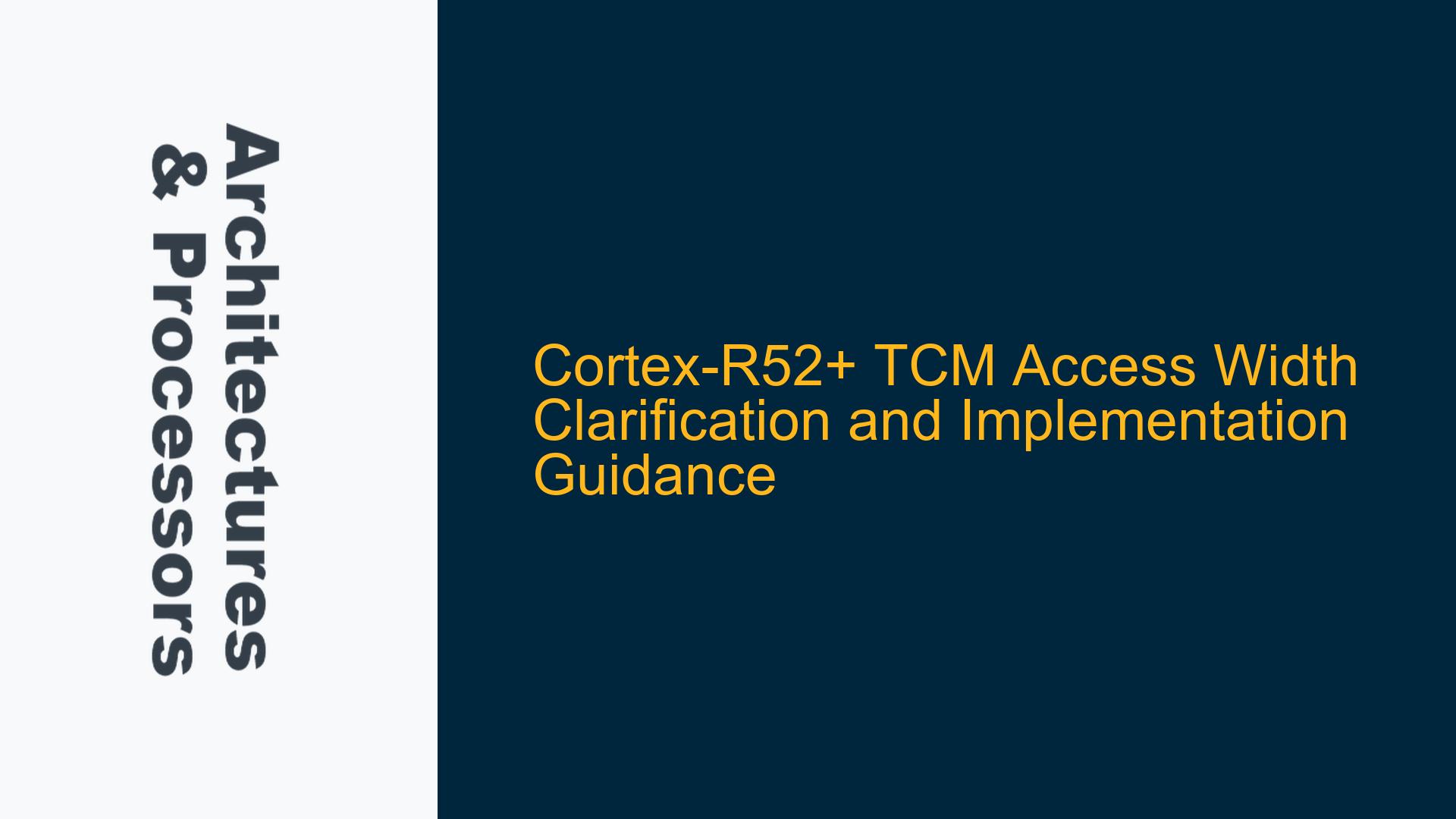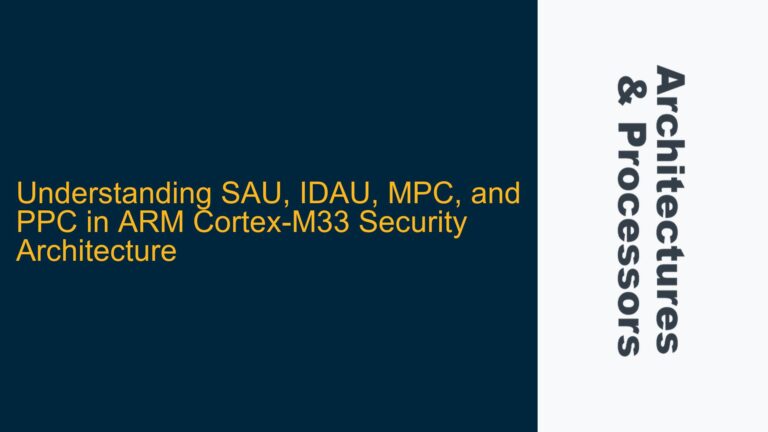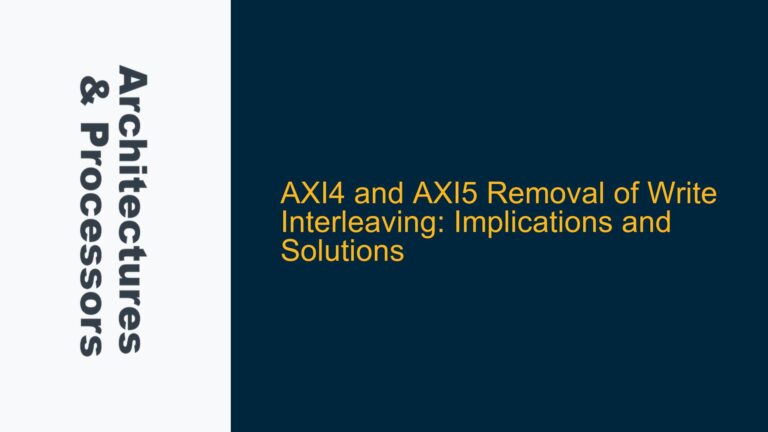Cortex-R52+ TCM Access Width Specifications and Ambiguities
The Cortex-R52+ processor, a highly configurable real-time processor from ARM, is widely used in safety-critical and high-performance embedded systems. One of its key features is the Tightly Coupled Memory (TCM), which provides low-latency, deterministic access for time-critical code and data. The TCM is divided into multiple banks, typically labeled TCM_A, TCM_B, and TCM_C, each serving specific purposes such as instruction storage, data storage, or shared memory. However, the Technical Reference Manual (TRM) for the Cortex-R52+ provides detailed information about the access widths for the flash interface (128-bit) and the AXIM interface (128-bit) but leaves the access width for the TCM interfaces unspecified. This omission can lead to confusion during SoC design and integration, particularly when configuring the memory subsystem or optimizing data throughput.
The TCM access width is a critical parameter for system architects and designers because it directly impacts the memory bandwidth, latency, and overall performance of the system. For instance, a narrower access width might limit the data transfer rate between the TCM and the processor core, while a wider access width could improve performance but may require additional logic for alignment and buffering. Furthermore, the access width influences the design of the memory controller, bus fabric, and any direct memory access (DMA) engines that interact with the TCM.
The lack of explicit documentation on TCM access width in the TRM suggests that this parameter might be configurable or dependent on the specific implementation of the Cortex-R52+ in a given SoC. However, this ambiguity can lead to design challenges, especially when integrating third-party IP blocks or when porting software from other ARM Cortex processors that have different TCM configurations. To address this issue, it is essential to analyze the Cortex-R52+ architecture, review related documentation, and consider practical implementation scenarios to deduce the likely access width and provide actionable guidance for designers.
Potential Causes of TCM Access Width Ambiguity in Cortex-R52+
The ambiguity surrounding the TCM access width in the Cortex-R52+ TRM can be attributed to several factors. First, the Cortex-R52+ is designed to be highly configurable, allowing SoC designers to tailor the processor to their specific application requirements. This configurability extends to the TCM, where parameters such as size, organization, and access width might be adjustable during the implementation phase. As a result, the TRM might not specify a fixed access width to accommodate different use cases and configurations.
Second, the TCM access width could be implicitly determined by the interface protocol used to connect the TCM to the processor core. For example, if the TCM interface uses the AMBA AXI protocol, the access width might align with the AXI data bus width, which is typically 64-bit or 128-bit. However, this alignment is not explicitly stated in the TRM, leaving designers to infer the relationship between the interface protocol and the TCM access width.
Third, the TCM access width might depend on the physical implementation of the memory banks. In some cases, the TCM could be implemented using standard SRAM macros with fixed access widths, such as 32-bit or 64-bit. The processor core would then access the TCM using the native width of the SRAM, potentially requiring additional logic for wider accesses. This implementation detail might not be documented in the TRM, as it is considered part of the physical design rather than the architectural specification.
Finally, the ambiguity could stem from the assumption that the TCM access width is consistent with other interfaces in the Cortex-R52+, such as the flash interface and AXIM interface, both of which have a 128-bit access width. However, this assumption might not hold true for all implementations, particularly in cost-sensitive or power-constrained designs where narrower access widths are preferred.
Determining TCM Access Width and Implementation Strategies
To resolve the ambiguity surrounding the TCM access width in the Cortex-R52+, designers can follow a systematic approach that combines architectural analysis, simulation, and practical experimentation. The first step is to review the Cortex-R52+ TRM and related documentation for any indirect references to the TCM access width. For example, the TRM might provide timing diagrams or performance metrics that imply a specific access width. Additionally, designers can consult the ARM CoreSight documentation or the implementation guide for the Cortex-R52+ to gather further insights.
If the documentation does not provide a definitive answer, designers can use simulation tools to analyze the behavior of the TCM interface. By creating a testbench that models the TCM and its interaction with the processor core, designers can observe the data transfer patterns and infer the access width. This approach requires a detailed understanding of the AMBA protocols and the ability to interpret simulation waveforms.
Another practical strategy is to examine the configuration options available in the Cortex-R52+ implementation tools, such as ARM’s CoreLink or DesignStart. These tools often provide parameters for configuring the TCM, including the access width. By exploring these options, designers can identify the supported access widths and select the one that best meets their requirements.
Once the TCM access width is determined, designers can proceed with the implementation. For a 128-bit access width, the TCM interface should be designed to handle 128-bit data transfers, with appropriate alignment and buffering logic. The memory controller should be configured to support burst transfers and ensure efficient utilization of the bus bandwidth. If the access width is narrower, such as 64-bit or 32-bit, the design should include logic for splitting wider accesses into multiple narrower transactions.
In cases where the TCM access width is configurable, designers should evaluate the trade-offs between performance, area, and power consumption. A wider access width can improve performance but may increase the area and power overhead, while a narrower access width might reduce costs but limit throughput. The optimal configuration depends on the specific application requirements and constraints.
To validate the TCM implementation, designers should conduct thorough verification, including functional testing, performance analysis, and corner case testing. The verification plan should cover all possible access patterns, including single transfers, burst transfers, and concurrent accesses from multiple masters. Additionally, designers should test the TCM under different operating conditions, such as varying clock frequencies and voltage levels, to ensure robustness.
In conclusion, while the Cortex-R52+ TRM does not explicitly specify the TCM access width, designers can deduce this parameter through a combination of architectural analysis, simulation, and practical experimentation. By following a systematic approach and considering the trade-offs between performance, area, and power, designers can implement a TCM that meets the requirements of their specific application.






